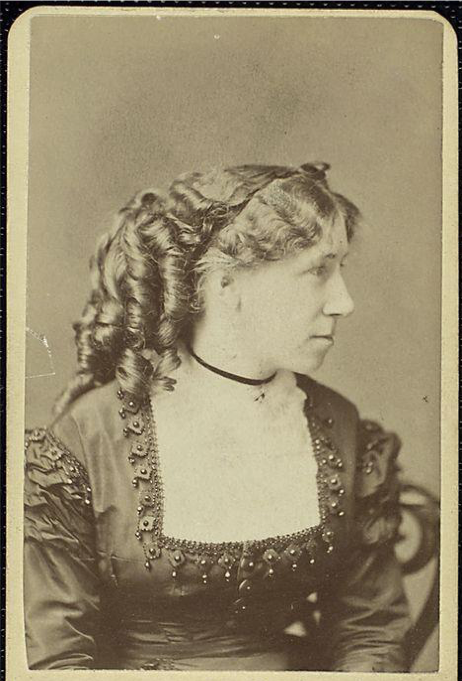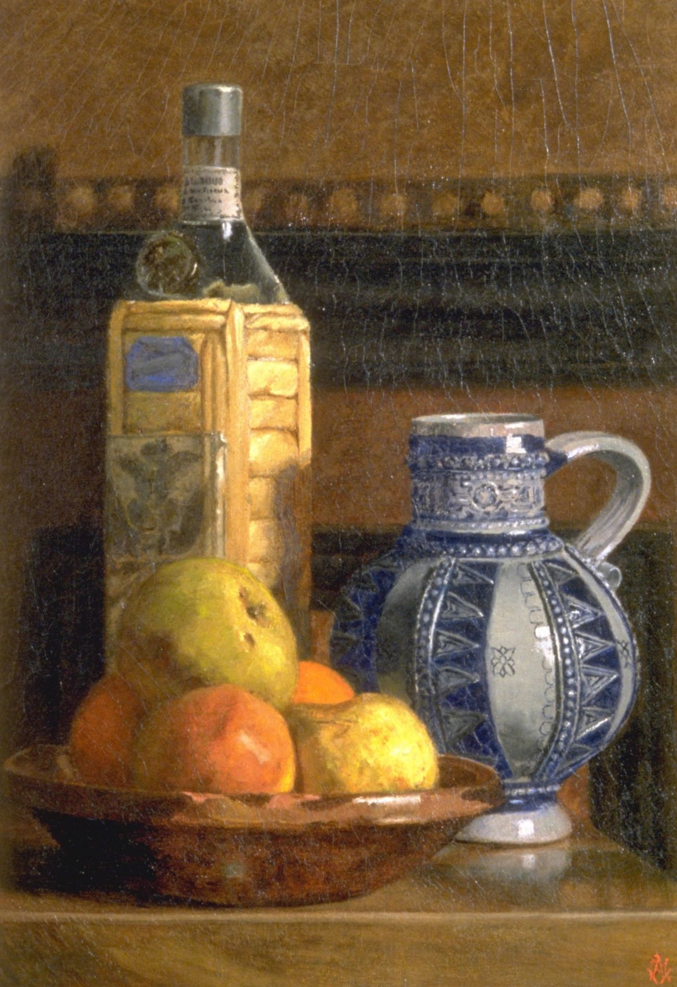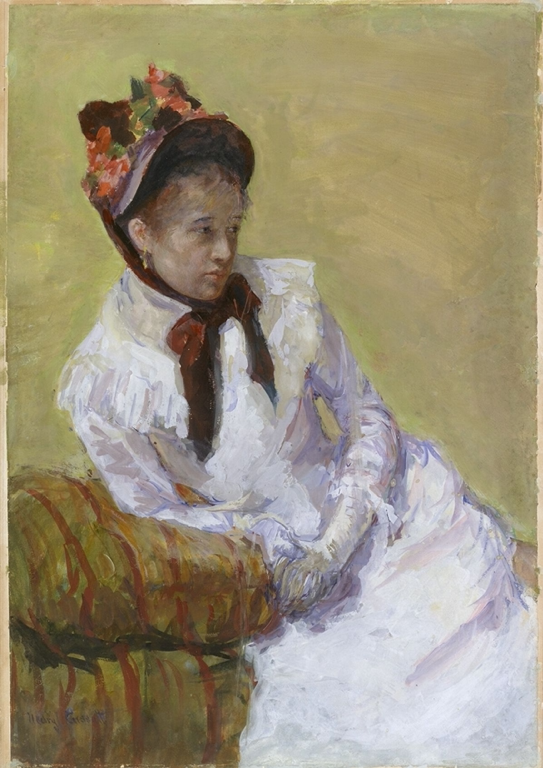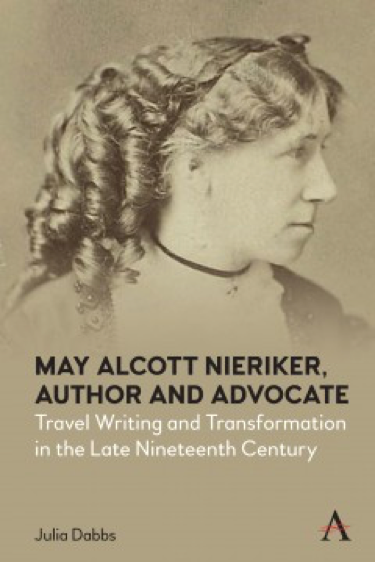Guest post by Julia Dabbs, University of Minnesota, Morris
“Concord people will be amazed by it.” So wrote artist and author May Alcott Nieriker (1840–1879), youngest sister of famed author Louisa May Alcott, in an 1877 letter to her family. She was referring to a striking portrait of herself (Figure 1), painted by friend and fellow New Englander Rosa Peckham (1842–1922), who shared living quarters with May while the two studied painting in Paris.

They, like other American artists of the period, had come to Paris in the late 1870s to advance their skills in drawing the human figure and in oil painting so as to enhance their professional careers. Additionally, the women could immerse themselves in the Parisian art world without the demands of family life that beset them back home, as well as potentially exhibit their work in one of the most esteemed venues of the day, the highly competitive Paris Salon. In fact, Peckham’s portrait of May was intended for submission to the Salon in 1877, but could not be completed in time despite a valiant effort.
The portrait, which is a modest 25 x 21” and is currently displayed in the Alcott family home of Orchard House (Concord, MA), is the only painted image of the artist yet identified, even though other women artists in May’s Parisian circle are known to have used her as a model. Dressed in an elegant peacock-blue ruffled chapeau and gown, May looks directly at the viewer, but her frank gaze is softened by the slight tilt of her head and the play of shadow across half of her face. The contrast of light and dark is quite striking; the shaded right side evokes a sense of melancholy wistfulness, perhaps suggestive of May’s separation from her family,while the brighter left side captures her effervescent cheerfulness. The light glistens on her abundant chestnut-gold curls, which are discretely pulled back yet still allowed to play gracefully across her shoulder, thereby indicating the sitter’s independent nature, since typically women’s hair would have been pulled back and controlled in a snood.
Transforming May
May, who perhaps too modestly referred to herself as an “ugly duckling,” was surprised by the pictorial transformation created by her friend Rosa:
I find it very interesting to see how I look to other people and am surprised that they succeed in making such pleasing, effective pictures of such a plain woman. Rose acknowledged that she hardly suspected what picturesque material was to be found in this oldish girl dressed in plain black all the time, and that a bit of blue and a dashing hat, with a curl or two waving in the breeze, entirely transformed me.
Compared to a photographic portrait of May (Figure 2), which is dated to c.1870 and perhaps was made in conjunction with her first trip to Europe, the transformation is indeed rather stunning. The poses themselves are significant choices: in the photo portrait May’s torso is positioned three-fourths frontal with her head turned sharply in profile, which was a standard pose for a carte-de-visite. This format usefully allowed for physiognomic identifiability while simultaneously projecting social propriety given the lack of direct eye contact with the female subject.

However, in the painted portrait May’s head is turned toward the viewer in a more intimate manner, and her hair color is now auburn rather than dark brown. Even her physical features were manipulated, per May’s direction: she asked Rosa to make “the mouth smaller, the chin shorter, the eyes longer, etc.” to create a younger, more idealized version of herself, as might be desired by a woman now in her late thirties. Furthermore, the rather severe, high-neck black and white gown has been replaced by a gorgeous peacock blue dress with an open, slightly plunging neckline accentuated by frilly white lace. The ruffled blue chapeau indeed sets off this fashion-forward presentation, which in toto asserts that this is a successful, well-to-do woman.
Art and Reality
Yet, in reality that was not the case. As of 1877 May Alcott had achieved some notoriety as a copyist of paintings by J.M.W. Turner, but her earnings as an artist and art teacher were insufficient to fund her study abroad. So, as she had been on past trips, May was again aided financially thanks to the generosity of her sister Louisa, who was enjoying great publishing success as a novelist. And although May apparently did own this beautiful dress, at the time she was still a student in the studio of Edouard Krug, with no paintings yet accepted into the Paris Salon or other venues. May was, however, on the verge of success, as she had an accomplished still-life accepted just months later in the 1877 Salon (Figure 3).

Could she, or Rosa, sense that imminent achievement, or was this portrayal a kind of wish fulfillment? Nevertheless, there are no explicit indications of her identity as an artist, which were fairly common in self-portraits by women in the period. May does wear an unusual pair of bright red pendant earrings which add an artful element to this representation, but the overall intent seems to have been to present herself as a fashionable woman, as her Parisian friend Mary Cassatt would do slightly later in her Portrait of the Artist (Figure 4).

In so doing, Alcott Nieriker’s portrait takes on a performative role, not unlike what she experienced internally when she crossed the ocean to follow her artistic dreams: “As soon as I land on this side [i.e. of the Atlantic] it always seems as if I was someone else, whose actions I followed with interest but take no actual part in, and in a measure I lost my identity and feel like a heroine in some novel, more than anything else” (letter to her mother, November 26, 1876).
Coming Home
Although the portrait of May did not make it to the Paris Salon, it received a more significant—and potentially more critical—viewing when sent to the Alcott family in Concord. When the portrait arrived in May 1877 the Alcotts rejoiced, welcoming it as if May herself had come home. Her mother Abigail wrote:
Great day for the Alcotts […] Miss Peckham has caught May’s air and pose most successfully, and her ‘suaviter in mode’ of tone… of ten years ago when her eyes were bright, and her heart was light, and she thought of love and glory. The tone of high coloring is more the fashion than it has been, everything is more intense; Life itself is short and swift. […] The picture is May and nobody else, but the hat is Madame Milliner’s “Salon Chapeau.” May’s own pretty hair, with her blue velvet snood, would have suited my taste better, but Paris is all crimson and gilt, nude or dressed for exhibition.
Thus, the Parisianization of May was quite evident to her mother (and no doubt to other family members), yet they could still see that beneath the plumage, those were May’s curls, her warm smile, and her frank gaze. May writes in a letter that she wanted the portrait exhibited in a Boston gallery upon its arrival in order to augment her fame (indicating yet another function of the portrait). But I suspect that her parents were loath to let the painted surrogate leave the home as there is no evidence that it was exhibited elsewhere. Indeed, the portrait soon became enshrined in Orchard House (Figure 5), where the family interacted with it in their daughter’s absence. May even suggested that the portrait be situated on a chair there, thus becoming a visual place marker for her while she was abroad.

She also presciently envisioned the portrait’s potential as a visual memorial, writing that “if anything should happen to me so I never returned it is a likeness which I should wish to be remembered by as it idealises my bad points & exaggerates my good ones just enough.” Sadly, May never did return home, for after marrying a young Swiss businessman (Ernest Nieriker) in 1878, she died in their Parisian home in December 1879, some six weeks after having given birth to a daughter, named Louisa May (“Lulu”) after her sister. Yet through the portrait’s visual complexities, Rosa Peckham has captured the essences of a woman who could not be neatly categorized as a nineteenth-century “True” or “New” Woman, dutiful daughter or independent artist. May Alcott Nieriker was all of these, to our continuing amazement.
Julia Dabbs is a Distinguished University Teaching Professor of Art History at the University of Minnesota, Morris. Her research focuses on the lives and creations of early modern European and nineteenth-century American women artists. As part of this research, Julia has published three essays and a book on May Alcott Nieriker; the content for this blogpost derives in part from the latter (May Alcott Nieriker, Author and Advocate). The author’s next project is a monograph focusing on the art and letters of Alcott Nieriker. Visit her webpage here.

Other Art Herstory posts you might enjoy:
Emma Stebbins, Anne Whitney and Vinnie Ream: American Women Sculptors of the Nineteenth Century, by Maria Ausherman
Women Artists at the Cape Ann Museum, by Erika Gaffney
An Introduction to Minnie Jane Hardman, by Hannah Lyons
The Floral Art of Emily Cole, by Erika Gaffney
Helen Allingham’s Country Cottages: Subverting the Stereotype, by Amy Lim
Illuminating Sarah Cole, by Kristen Marchetti
Defining Moments: Mary Cassatt and Helen McNicoll in 1913, by Julie Nash
Women Reframe American Landscape at the Thomas Cole National Historic Site, by Erika Gaffney
New Adventures in Teaching Art HerStory, by Julia Dabbs
Laura Seymour Hasbrouck, A Painter of the Hudson River School, by Lili Ott
Susie M. Barstow: Redefining the Hudson River School, by Nancy Siegel
The Rich and Complex Character of May Morris, Designer, Embroiderer, Jeweller and Writer, by Thomas Cooper
Marie Spartali Stillman’s The Last Sight of Fiammetta, by Margaretta S. Frederick
Visual Feasts: The Art of Sarah Mapps Douglass, by Erika Viola
Evelyn De Morgan: Painting Truth and Beauty, by Sarah Hardy
Portraying May Alcott Nieriker, by Julia Dabbs




Trackbacks/Pingbacks